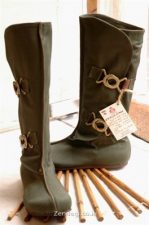 Our clothes are an integral part of our lives–they can reflect the type of work we do, our beliefs and even our moods. So it may come as a shock to know that our clothes can also pose a health risk and do serious damage to the environment.
Our clothes are an integral part of our lives–they can reflect the type of work we do, our beliefs and even our moods. So it may come as a shock to know that our clothes can also pose a health risk and do serious damage to the environment.
Most people prefer to wear 100% cotton clothes believing this to be the best option. It’s a naturally grown fibre, what could be better?
But it turns out that your conventional cotton T-shirt just isn’t what you thought it was. Cotton is in the top three of worst offenders for environmental damage in agriculture, with a very high price to boot for the people growing it.
The World Health Organization estimates thousands of deaths annually from the use of highly toxic chemicals for growing cotton. Yet more highly toxic chemicals (at least 8,000) are used in the processing and manufacturing of cotton, and they then add chemicals such as formaldehyde, which leave residues in the fabric, exposing you to skin irritants. It is well known recommendation by doctors to dress children suffering from eczema in organic cotton clothing.
The good news is that more and more organic cotton clothing for children and adults is available today.
Organic cotton clothing falls into two categories: 1. Clothing made from organically grown cotton. 2. Clothing made from organically grown cotton which is then processed and manufactured following strict ecological guidelines. For example they do not use chlorine based bleaches to whiten the fabric, nor do they use heavy-metal based dyes, azo-dyes, nickel based zippers or accessories, and no chemical finishes are added. All this promises you the cleanest, highest quality cotton possible.
So how do I know which is which? Well to buy an 100% organically made T-Shirt, you need to look for certification. There are several organizations that inspect and certify the manufacturing process, including Demeter, EKO Sustainable Textiles (SKAL) and Agreco. It is always best to support organic agriculture and buy clothing made from 100% organic cotton, but if it has no certification for manufacturing, the chances are that the finished items have chemical residues in them.
It is also very important to know that babies and children are far more sensitive to these residues; their bodies are still developing and their bodies work and breathe faster, increasing their intake of chemicals in their environment. One of the biggest concerns is that when dressed, our bodies heat our clothing causing chemicals present to emit gases, making it a lot easier for our bodies to absorb them.
So where to find organic cotton clothes? Tinok Yarok sells baby clothes made from 100% certified organic cotton (SKAL), following fair trade practices for baby’s first year. It is highly recommended that the first layer of clothing next to the baby’s skin be organic, and the rest go second hand. Baby clothes have short lives and can be passed between friends and family, making it the best eco option and financially easy. “Cotton,” which has several shops throughout the country, also designs a range of women’s clothes using organic cotton.
Note: It is very important to understand why organic cotton clothing is more expensive:
1. You are paying the true price, which includes the farmer’s price, the factory worker’s wage and work conditions, as well as the toxin-free manufacturing process.
2. If you buy a baby suit for ten shekels on the market, chances are it was made in the Far East, where workers routinely work under sweatshop conditions and children are often employed. There is no inspection process to follow the manufacturing process; cheap highly toxic chemicals are run of the mill, threatening the environment, the workers’ health and your own.
3. And cheap often means very low quality, so in the end you end up buying and spending more!
Lastly, if your closet is feeling unmanageable, consider custom closet organization systems that can clear the clutter and provide a nice design accent for your child’s closet.
Before you buy anything though, first check with your family and neighbors if they have any storage systems to give away.



I love your cute baby. What is her name?
Excellent post Sophie.